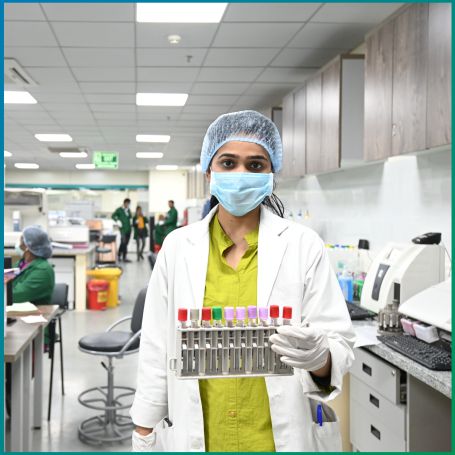
Immunohistochemistry (IHC) is a specialized laboratory test that detects specific proteins in tissue samples.


The IHC immunostaining test uses antibodies to visualize protein expression within a tissue sample, typically obtained from a biopsy. It involves staining the tissue sections to detect specific proteins or markers that can indicate the presence of diseases such as cancer, infections, and autoimmune conditions.
Purpose of the IHC Test
Cancer Diagnosis: IHC helps in identifying cancer markers, allowing for precise cancer classification and staging.
Infectious Disease Detection: IHC can detect certain infectious agents within tissue, such as viruses and bacteria.
Autoimmune and Inflammatory Disorders: The test can also identify markers of inflammation, aiding in the diagnosis of autoimmune diseases.
Immunohistochemical staining and Immunofluorescence are two techniques that serve similar purposes but differ in visualization methods. While IHC immunostaining relies on colored stains visible under regular light microscopy, Immunofluorescence uses fluorescent dyes that require special fluorescence microscopes. Both methods have their advantages; immunofluorescence immunohistochemistry is often used when high sensitivity and detailed localization are required.
The IHC test follows a multi-step procedure to analyze the presence and distribution of proteins within the tissue sample. Here’s how it’s done:
Preparation:
The patient undergoes a biopsy to collect the tissue sample.
No specific preparation is needed for the patient after the sample is collected.
Tissue Fixation:
The tissue sample is preserved in formalin and embedded in paraffin, which helps maintain tissue structure.
Sectioning and Staining:
Thin tissue sections are cut and placed on slides. Antibodies specific to the target protein are applied, binding to the protein of interest.
IHC immunostaining or Immunofluorescence immunohistochemistry techniques may be used to visualize the binding.
Analysis: Pathologists examine the stained tissue under a microscope, identifying the protein distribution and intensity.
The IHC test range is qualitative, meaning that rather than providing a numeric result, it indicates the presence and localization of specific proteins. Results are interpreted based on the intensity and spread of staining:
Negative: No specific staining observed.
Weak/Low Positive: Mild staining, indicating a low level of the protein.
Moderate Positive: Clear staining, with moderate protein presence.
Strong Positive: Intense staining, indicating high protein expression.
These results are used to confirm diagnoses, classify disease severity, and guide treatment planning.
Here’s why Diagnopein in Pune is an excellent choice for your Immunohistochemistry (IHC) test:
A)NABL Certified: Our laboratory is NABL-certified, ensuring top standards in accuracy and reliability for all tests, including IHC immunostaining.
B) Highly Skilled Technicians: Diagnopein employs trained professionals with expertise in complex staining techniques for clear and precise results.
C) Advanced Technology: We use state-of-the-art equipment, ensuring high sensitivity in Immunofluorescence immunohistochemistry and traditional IHC immunostaining.
D) Affordable Testing: Quality diagnostics shouldn’t be out of reach. Diagnopein offers competitive pricing on IHC tests, making advanced healthcare accessible.
E) Clean and Hygienic Facilities: We prioritize patient safety with clean, well-maintained labs for testing and sample collection.
A high Immature Platelet Fraction is not inherently dangerous but can indicate active platelet production due to factors such as bleeding, infection, or a hematologic condition. Further evaluation is necessary to understand its cause.
IHC immunostaining is used to detect specific proteins within tissues, assisting in diagnosing cancers, infections, and inflammatory conditions by revealing markers that help classify and understand the disease.
Normal levels vary based on factors such as age, gender, and health condition, so it’s best interpreted by a healthcare provider in the context of individual health data.
While both are used to detect protein markers, immunohistochemical staining uses dyes visible under regular light microscopy, while immunofluorescence uses fluorescent dyes that require specialized microscopes, often chosen for high sensitivity.